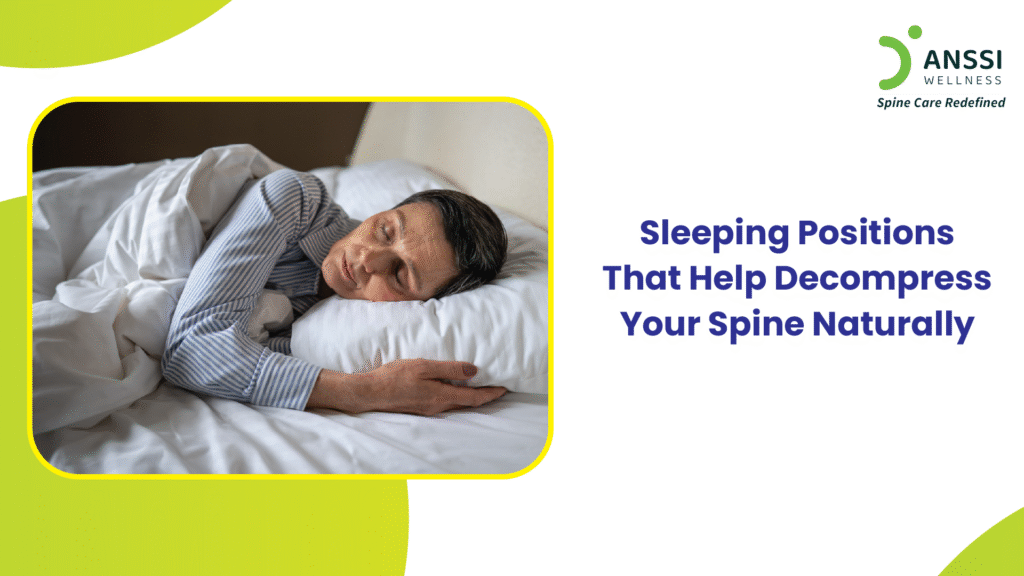A good night’s sleep does more than just recharge your energy; it offers your spine a vital opportunity to rest, heal, and decompress. Throughout the day, gravity, poor posture, and long hours of sitting can cause spinal compression, leading to back pain, stiffness, and disc-related issues. But with the right sleeping positions and habits, you can help your spine recover naturally during the night.
Let’s explore how sleep can support spinal health and which positions work best to decompress your spine.
Understanding Spinal Compression During the Day
Spinal compression occurs due to the constant gravitational pull exerted on the body throughout the day. Whether you’re working at a desk, standing for long hours, or slouching while using a phone, these habits create downward pressure on your spine. Over time, this pressure can reduce disc height, cause inflammation, and trigger pain in the neck, upper back, or lower back.
The intervertebral discs, the soft, gel-like cushions between the bones in your spine, act as shock absorbers. They need time to rehydrate and recover. Sleep is when the body is horizontal, reducing gravitational stress and allowing the discs to re-expand and heal. But this benefit can only be achieved if you maintain proper spinal alignment during sleep.
Best Sleeping Positions for Spinal Decompression
Not all sleeping positions support spinal health equally. Some may worsen spinal curvature or strain muscles. Here are the best positions that help decompress the spine naturally:
1. Back Sleeping with a Pillow Under the Knees
Sleeping flat on your back distributes weight evenly and keeps your head, neck, and spine aligned. Placing a pillow under the knees elevates the legs slightly and helps maintain the spine’s natural curve by reducing pressure on the lower back. This position is ideal for people with lumbar pain or spinal disc problems.
2. Sleeping on One Side With a Pillow Between the Knees
Side sleeping is a common and comfortable position, but it’s important to keep the hips and spine aligned. Placing a pillow between the knees prevents the top leg from pulling the spine out of alignment. It also reduces pressure on the hips and sacroiliac joints. This posture benefits those with sciatica, herniated discs, or sacroiliac joint dysfunction.
3. Fetal Position
Curling up slightly on your side with your knees drawn toward your chest can open up the spaces between vertebrae, especially in the lower back. This position is particularly beneficial for individuals with herniated discs, as it may relieve nerve compression and reduce pain. However, avoid curling too tightly, as it may restrict breathing and reduce spinal flexibility.
4. Reclined Back Sleeping (with Adjustable Bed or Wedge Pillow)
Some individuals with spinal stenosis or spondylolisthesis find relief in a reclined position. Using a wedge pillow or an adjustable bed to elevate both the head and knees can ease pressure on the lower spine and improve circulation. It mimics the “zero gravity” posture used in spinal decompression treatment.
Choosing the Right Mattress and Pillow
The best sleeping position won’t help much if your mattress and pillow are unsupportive. A proper sleep surface is essential for maintaining spinal alignment and promoting decompression.
Mattress Tips:
- Medium-firm mattresses offer the best support for most people, helping to keep the spine neutral without excessive sagging.
- Memory foam or latex mattresses contour to your body’s shape, offering relief to pressure points and providing consistent support across the spine.
- Avoid overly soft mattresses, as they can cause your spine to sink and misalign.
Pillow Tips:
- For back sleepers, choose a thin pillow that supports the natural curve of the neck. A cervical pillow or memory foam contour pillow is ideal.
- For side sleepers, a firmer pillow that fills the space between the ear and shoulder ensures neck alignment.
- For stomach sleepers (though not recommended), use a very thin pillow or none at all to avoid neck strain.
Additional Tips for Spinal Health During Sleep
In addition to choosing the right position and sleep surface, consider the following habits to enhance spinal decompression:
- Stretch before bed: Gentle stretches, such as child’s pose or knee-to-chest stretches, help relax spinal muscles.
- Maintain a consistent sleep schedule: Your spine, like the rest of your body, benefits from routine and adequate rest.
- Use lumbar or cervical rolls: For extra support, place a small rolled towel at the lumbar or cervical curve.
- Avoid high pillows: Overelevating your head can stress the cervical spine and cause neck pain.
When to Seek Professional Advice
If you experience persistent back pain, stiffness, or tingling despite following proper sleep hygiene, it’s important to consult a spine specialist. Sometimes, spinal compression is caused by more serious conditions such as disc herniation, spinal stenosis, or spondylosis. In such cases, non-surgical treatments like spinal decompression, physiotherapy, or posture correction may be needed alongside lifestyle changes.
About ANSSI:
ANSSI Wellness focuses on improving the quality of life for patients suffering from spinal issues, aiming to provide relief where other conventional treatments have failed. Through advanced non-surgical spinal decompression treatment, ANSSI is committed to helping patients avoid surgery and recover in a safe, effective, and compassionate environment.
Connect with ANSSI Wellness on LinkedIn, Instagram, and Facebook for expert guidance.




